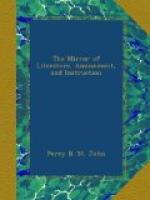The heir apparent of the crown of France derives his title of Dauphin from the following very singular circumstance. In 1349, Hubert, second Count of Dauphiny, being inconsolable for the loss of his heir and only child, who had leaped from his arms through a window of his palace at Grenoble into the river Isere, entered into a convent of jacobins, and ceded Dauphiny to Philip, a younger son of Philip of Valois (for 120,000 florins of gold each of the value of twenty sols or ten pence English,) on condition that the eldest son of the king of France should be always after styled “the Dauphin,” from the name of the province thus ceded. Charles V., grandson to Philip of Valois, was the first who bore the title in 1530.
* * * * *
THE OLD ELEPHANT, FENCHURCH-STREET.
[Illustration: THE OLD ELEPHANT, FENCHURCH-STREET.]
Everything connected with the name of HOGARTH is interesting to the English reader. He was apprenticed to a silversmith, and from cutting cyphers on silver spoons, he rose to be sergeant painter to the king—and from engraving arms and shop-bills, to painting kings and queens—the very top of the artist’s ladder. The soul-breathing impulses of genius enabled him to effect all this, and his example, (in support of the maxim, that “every man is the architect of his own fortune,”) will be respected and cherished, at home and abroad, as long as self-advancement continues to be the great stimulus to aspiring industry.
The old Elephant public-house therefore merits the attention of all lovers of painting and genius; for in it, previous to his celebrity, lodged WILLIAM HOGARTH. It was built before the fire of London, and although so near, escaped its ravages; but the house was pulled down a short time since, and another of more commodious construction erected on its site. On the wall of the tap-room, in the old house, were four paintings by Hogarth: one representing the Hudson’s Bay Company’s Porters; another, his first idea for the Modern Midnight Conversation, (differing from the print in a circumstance too broad in its humour for the graver,) and another of Harlequin and Pierot seeming to be laughing at the figure in the last picture. On the first floor was a picture of Harlow Bush Fair, covered over with paint. This information is copied from an old print picked up in our “collecting” rambles, at the foot of which it is stated to have been obtained from “Mrs. Hibbert, who has kept the house between thirty and forty years, and received her information relating to Mr. Hogarth from persons at that time well acquainted with him.” The paintings were, we believe, removed previous to the destruction of the old house.
To the searchers into life and manners, Hogarth’s moral paintings, to which branch of art the above belong, are treasures of great prize; and whether over his originals at the gallery in Pall Mall, or their copies at the printsellers—the Elephant in Fenchurch-street, or the “painting moralist’s” tomb in Chiswick churchyard—Englishmen have just cause to be proud of his name.




